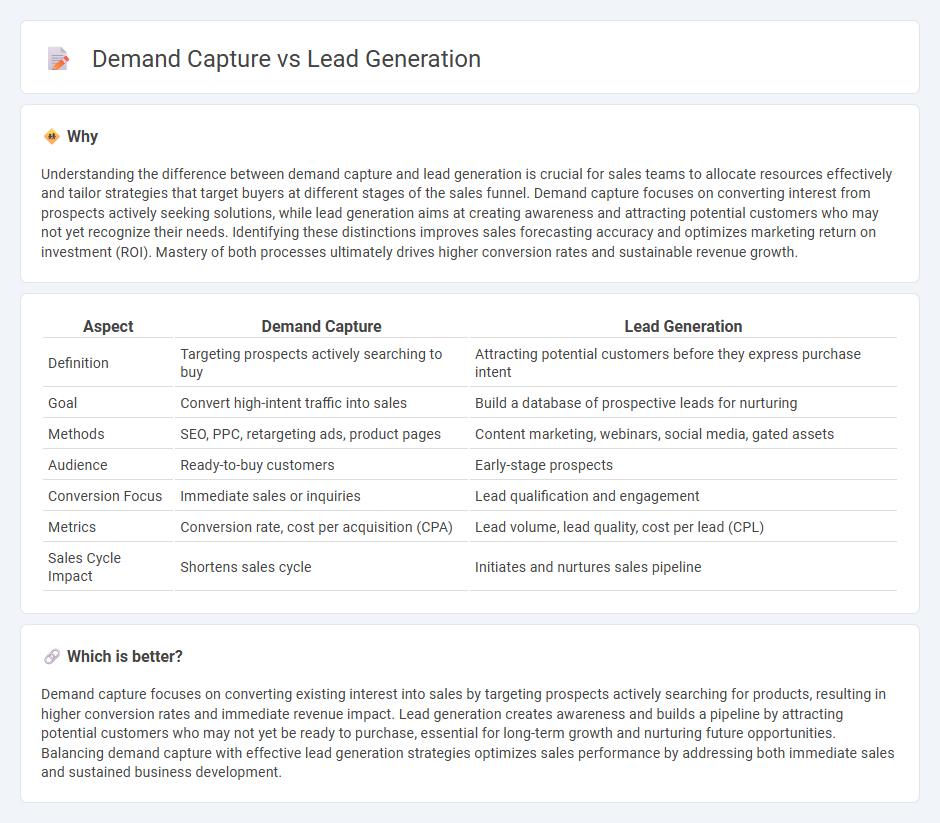
Demand capture focuses on converting existing interest into sales by targeting potential customers actively searching for products or services, whereas lead generation aims to create interest and attract prospects who may not yet recognize their need. Sales teams leverage demand capture strategies such as targeted ads and search intent analysis to close deals more efficiently, while lead generation employs content marketing and outreach campaigns to build a pipeline for future sales. Explore effective sales strategies to optimize both demand capture and lead generation for maximum revenue growth.
Why it is important
Understanding the difference between demand capture and lead generation is crucial for sales teams to allocate resources effectively and tailor strategies that target buyers at different stages of the sales funnel. Demand capture focuses on converting interest from prospects actively seeking solutions, while lead generation aims at creating awareness and attracting potential customers who may not yet recognize their needs. Identifying these distinctions improves sales forecasting accuracy and optimizes marketing return on investment (ROI). Mastery of both processes ultimately drives higher conversion rates and sustainable revenue growth.
Comparison Table
| Aspect | Demand Capture | Lead Generation |
|---|---|---|
| Definition | Targeting prospects actively searching to buy | Attracting potential customers before they express purchase intent |
| Goal | Convert high-intent traffic into sales | Build a database of prospective leads for nurturing |
| Methods | SEO, PPC, retargeting ads, product pages | Content marketing, webinars, social media, gated assets |
| Audience | Ready-to-buy customers | Early-stage prospects |
| Conversion Focus | Immediate sales or inquiries | Lead qualification and engagement |
| Metrics | Conversion rate, cost per acquisition (CPA) | Lead volume, lead quality, cost per lead (CPL) |
| Sales Cycle Impact | Shortens sales cycle | Initiates and nurtures sales pipeline |
Which is better?
Demand capture focuses on converting existing interest into sales by targeting prospects actively searching for products, resulting in higher conversion rates and immediate revenue impact. Lead generation creates awareness and builds a pipeline by attracting potential customers who may not yet be ready to purchase, essential for long-term growth and nurturing future opportunities. Balancing demand capture with effective lead generation strategies optimizes sales performance by addressing both immediate sales and sustained business development.
Connection
Demand capture focuses on identifying and engaging potential customers actively seeking products or services, directly feeding high-quality leads into the sales funnel. Lead generation involves creating interest and attracting prospects through targeted marketing efforts, which expands the pool of potential customers. Together, these processes optimize conversion rates by aligning marketing strategies with customer intent, enhancing overall sales effectiveness.
Key Terms
Lead Generation: Prospecting, Outreach, Qualification
Lead generation emphasizes prospecting by identifying potential customers through targeted data analysis and market segmentation to build a high-quality pipeline. Outreach involves personalized communication strategies such as email campaigns, social media engagement, and cold calling to initiate contact and stimulate interest. Qualification assesses prospects' needs, budget, and decision-making authority to prioritize leads most likely to convert, ensuring efficient resource allocation and higher sales success. Explore more about effective lead generation techniques to boost your sales funnel.
Demand Capture: Intent Data, Inbound Marketing, Conversion
Demand capture leverages intent data to identify high-potential prospects actively seeking solutions, enabling precise targeting through inbound marketing strategies that attract and engage qualified leads. This process emphasizes converting interest into action by optimizing landing pages, personalized content, and seamless call-to-action experiences to maximize conversion rates. Explore in-depth techniques and tools to enhance demand capture effectiveness and drive measurable business growth.
**Lead Generation:**
Lead generation centers on attracting and capturing potential customers' interest through targeted content, email marketing, and social media campaigns to build a qualified prospect database. By leveraging SEO, landing pages, and lead magnets, businesses can nurture initial awareness into actionable sales opportunities. Explore deeper strategies and tools to optimize your lead generation efforts and boost ROI.
Source and External Links
What is lead generation? - Adobe Experience Cloud - Lead generation involves attracting and nurturing potential customers through creating tailored content, promoting it via inbound (e.g., social media, SEO) or outbound (e.g., cold calls, ads) strategies, then collecting and nurturing their contact info to convert interest into sales.
What is Lead Generation? Beginner's Guide for 2025 - Cognism - Lead generation is the process of generating consumer interest and converting it, using inbound methods like content marketing and SEO or outbound methods like cold calling and paid advertising to attract and engage prospects.
What is Lead Generation? (+ Tips How to Do It) - Mailshake - Lead generation is attracting prospects and converting them into interested customers via strategies such as content marketing, email campaigns, social media, referral programs, and leveraging lead generation tools for automation and tracking.
 dowidth.com
dowidth.com